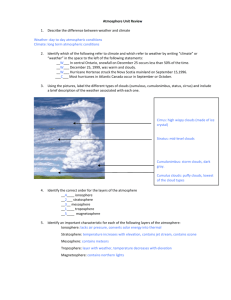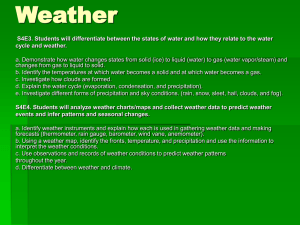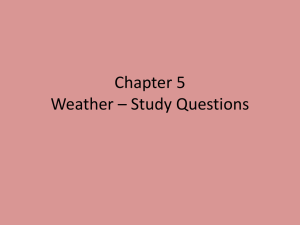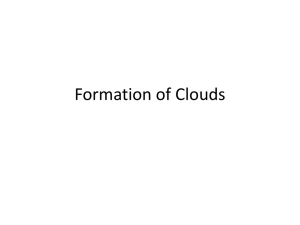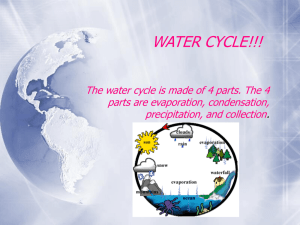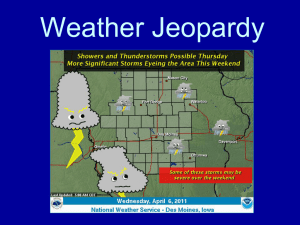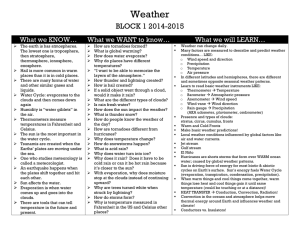Air and the Atmosphere
advertisement
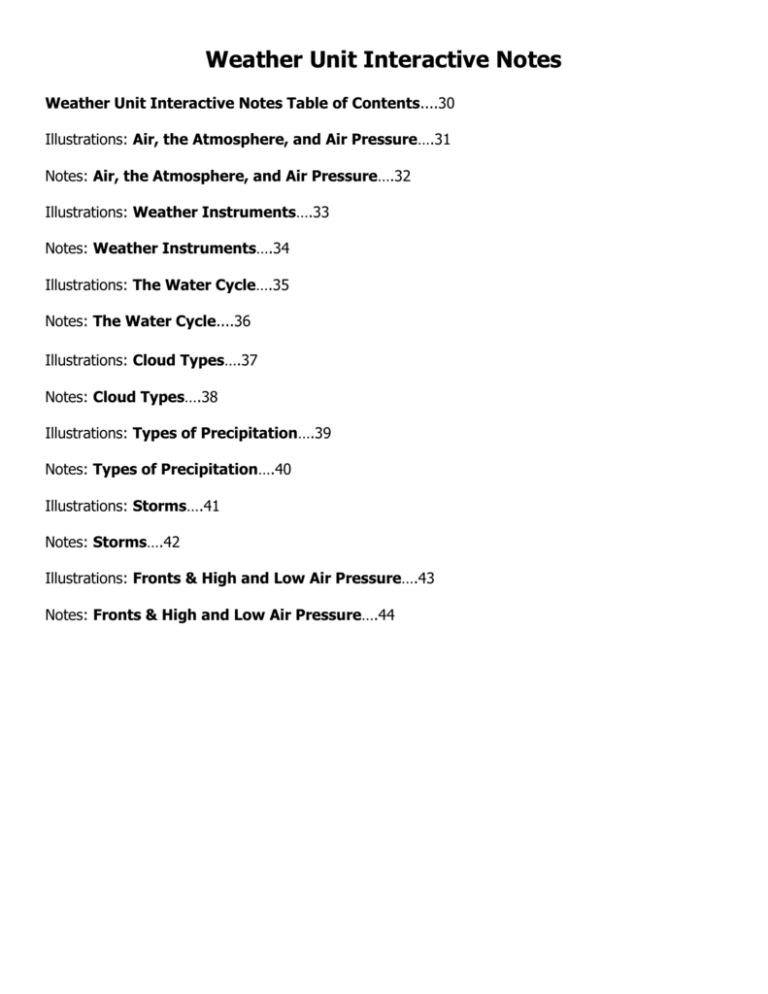
Weather Unit Interactive Notes Weather Unit Interactive Notes Table of Contents....30 Illustrations: Air, the Atmosphere, and Air Pressure….31 Notes: Air, the Atmosphere, and Air Pressure….32 Illustrations: Weather Instruments….33 Notes: Weather Instruments….34 Illustrations: The Water Cycle….35 Notes: The Water Cycle....36 Illustrations: Cloud Types….37 Notes: Cloud Types….38 Illustrations: Types of Precipitation….39 Notes: Types of Precipitation….40 Illustrations: Storms….41 Notes: Storms….42 Illustrations: Fronts & High and Low Air Pressure….43 Notes: Fronts & High and Low Air Pressure….44 Air, the Atmosphere, and Air Pressure We have weather because we have air, an atmosphere, and air pressure. The atmosphere is a blanket of air that surrounds the Earth. The Earth’s gravity holds it in place. The atmosphere is made up of 4 different layers and the lowest layer is the troposphere, where all of our weather occurs. Air pressure is the push of air against its surroundings. It is the result of the weight of the air. Air that weighs more has greater air pressure and air that weighs less has less air pressure. The closer you get to Earth, the greater the air pressure gets because there are more air particles. The higher you go in the atmosphere, the less air pressure there is because there are fewer air particles. Air pressure is figured out by temperature. Cool air weighs more than warm air because the particles are closer together. This usually gives us a higher air pressure. In warm air, the air particles are spread farther apart, so they have less weight. This gives us lower air pressure. Weather Instruments A meteorologist is a person who studies the weather. When a meteorologist wants to predict the weather, he or she has to use several different types of weather instruments to gather data for their predictions. A thermometer measures the temperature of the air. The temperature is the amount of heat energy in the atmosphere. Meteorologists use them to predict the temperature for the day. A barometer measures air pressure. High air pressure indicates fair weather, and low air pressure indicates stormy weather. When the meteorologist tells us that the barometer is falling, it usually means that stormy weather is coming. An anemometer measures wind speed. It looks like a bunch of cups spinning around a stick. The faster the anemometer spins, the faster the wind is blowing. A rain gauge measures the amount of precipitation. It usually looks like a tube with a ruler on it. After it rains, the meteorologist checks the rain gauge to measure how much rain has fallen. The Water Cycle The water cycle is the cycle of Earth’s water through evaporation, condensation, and precipitation. Clouds are formed when heat from the sun warms water in oceans, lakes, ponds, and streams. As the water gets warm, it evaporates, or turns into a gas, and rises into the air. The higher the evaporated water rises, the cooler it gets. As the water vapor cools, it condenses into water droplets, which form clouds. Sometimes the water vapor condenses into water droplets that are so heavy, they fall back down to the Earth as precipitation, and flow back into oceans, lakes, and streams. Then the cycle starts all over again. Cloud Types There are many, many different types of clouds, and each type is associated with a different type of weather. Knowing your cloud types can help you predict the weather. The 4 basic types of clouds are cirrus, stratus, cumulus, and cumulonimbus. Cirrus clouds are feathery clouds that are high up in the sky. They are wispy and transparent. They are associated with fair (good) weather. However, they may indicate that rain or snow will fall within several hours. Stratus clouds are smooth, gray clouds that cover the whole sky and block out direct sunlight. They look like a blanket in the sky. Light rain and drizzle are usually associated with stratus clouds. Cumulus clouds are fluffy and white with flat bottoms. They look like giant cotton balls. They are usually associated with fair weather. However, when they get larger and darker on the bottom, they become cumulo-nimbus clouds. Cumulo-nimbus clouds are giant, black, fluffy clouds that may bring thunderstorms or tornadoes. Types of Precipitation All forms of precipitation start as water vapor that condenses around microscopic particles. Rain forms when the cloud droplets coalesce, or come together, and the air temperature and ground temperature are above freezing. Snow forms when the cloud droplets coalesce, and the air temperature is below freezing. If the ground temperature is also below freezing, the snow will accumulate, but if it is not, the snow will melt. Sleet forms when the air temperature is below freezing which makes the rain drops freeze, but the ground temperature is above freezing, so it makes surfaces slick and wet. Hail forms in cumulo-nimbus clouds, which can be up to a mile high and are very windy inside. Cold air in the cloud turns droplets into ice crystals. As the crystals fall and pick up water vapor, they get caught in an updraft and refreeze. This happens over and over again until they are heavy enough to fall from the clouds as hail. Storms Thunderstorms are formed when warm, moist air rises rapidly, forming cumulonimbus clouds. They often form along cold fronts. Thunderstorms produce heavy rain, wind, lightning, thunder, and sometimes hail. The rain from the storms can cause flash floods, and the lightning can cause fires, damage property, and hurt people. Hurricanes form in the tropics over oceans between June and November, when huge amounts of warm, moist air get pushed higher by colder, heavier air, creating a violent, whirling storm. Hurricanes are low pressure areas. They have winds of 74-150 miles per hour and can travel up to 80 m.p.h. They can cover an area as wide as 360 miles. In the center of the hurricane is a calm area called the eye, where the sun shines and the sky is clear. They cause damage with strong winds, heavy rains that cause floods, and giant waves that smash into shore. They usually die out once they reach land or move over cold ocean water. Tornadoes form over land, occurring most commonly in the US, in the spring and early summer, when cold, heavy air is pushed over warm, moist air. The warm, moist air pushes itself through the layer of cold air with a spiraling motion. Strong winds form around a center of low pressure, forming a tornado. Tornadoes have winds of up to 500 m.p.h. and can move from 25-40 m.p.h. They are accompanied by lightning, heavy rain, wind, and last about 8 minutes. The strong winds of the tornado destroy almost everything in its path. The low pressure inside of the tornado can cause buildings to explode, and can suck up trees, cars, houses, people and animals. Fronts & High and Low Air Pressure A front is the boundary between air masses of different temperatures and humidity. There is usually some sort of precipitation along the front, because there is usually warm, moist air rising, which causes precipitation. In a cold front, a cold air mass moves under a warm air mass. A cold front brings brief, heavy precipitation, and then colder weather. In a warm front, a warm air mass moves up a slope of a cold air mass. A warm front brings steady, light precipitation, and then warmer weather. Large masses of air with different pressures move over the Earth. Cold masses of air have higher pressures than warm masses of air. These different air masses bring different types of weather. A low pressure system usually brings stormy weather. This bad weather covers a large area. A low pressure system is shown with an L on a weather map. A high pressure system brings sunny weather. It is usually shown with an H on a weather map.



